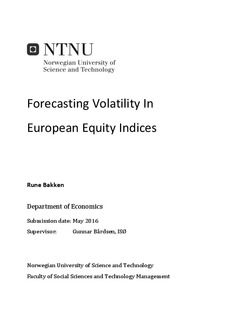| dc.description.abstract | In this thesis first order univariate GARCH models are applied to three European equity indices, DAX30, FTSE100 and OMXS30. The objective is to determine which one of the included models is best suited for out-of-sample variance forecasting while also investigating whether in-sample model fit measures provide a good indication. Models
will also be fitted to symmetric and skewed Student t distributions, in addition to the
normal distribution, to see if forecasting accuracy benefits noticeably. The included forecasting models are: the standard GARCH model, the EGARCH model, the GJR-GARCH model, the equally weighted moving average and the exponentially weighted moving average. Empirical results show that the normal GJR-GARCH model should be preferred for forecasting. It does not outperform in every case it but it is very reliable. Assuming a non-normal conditional distribution generally does not help on forecasting performance. Information criteria, which are used to measure in-sample fit, favor nonnormal asymmetric GARCH models. | nb_NO |
